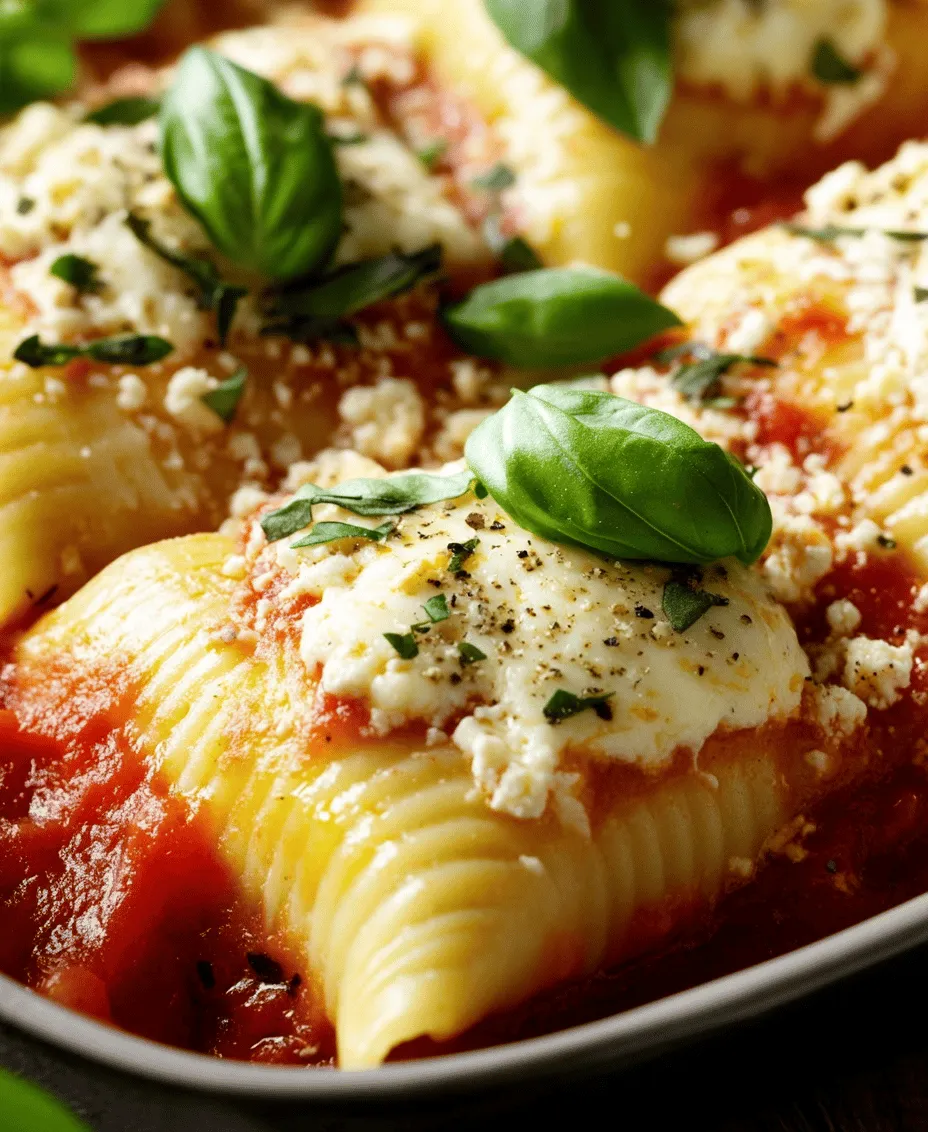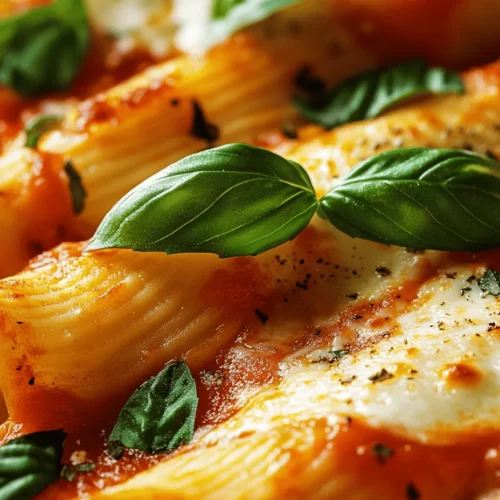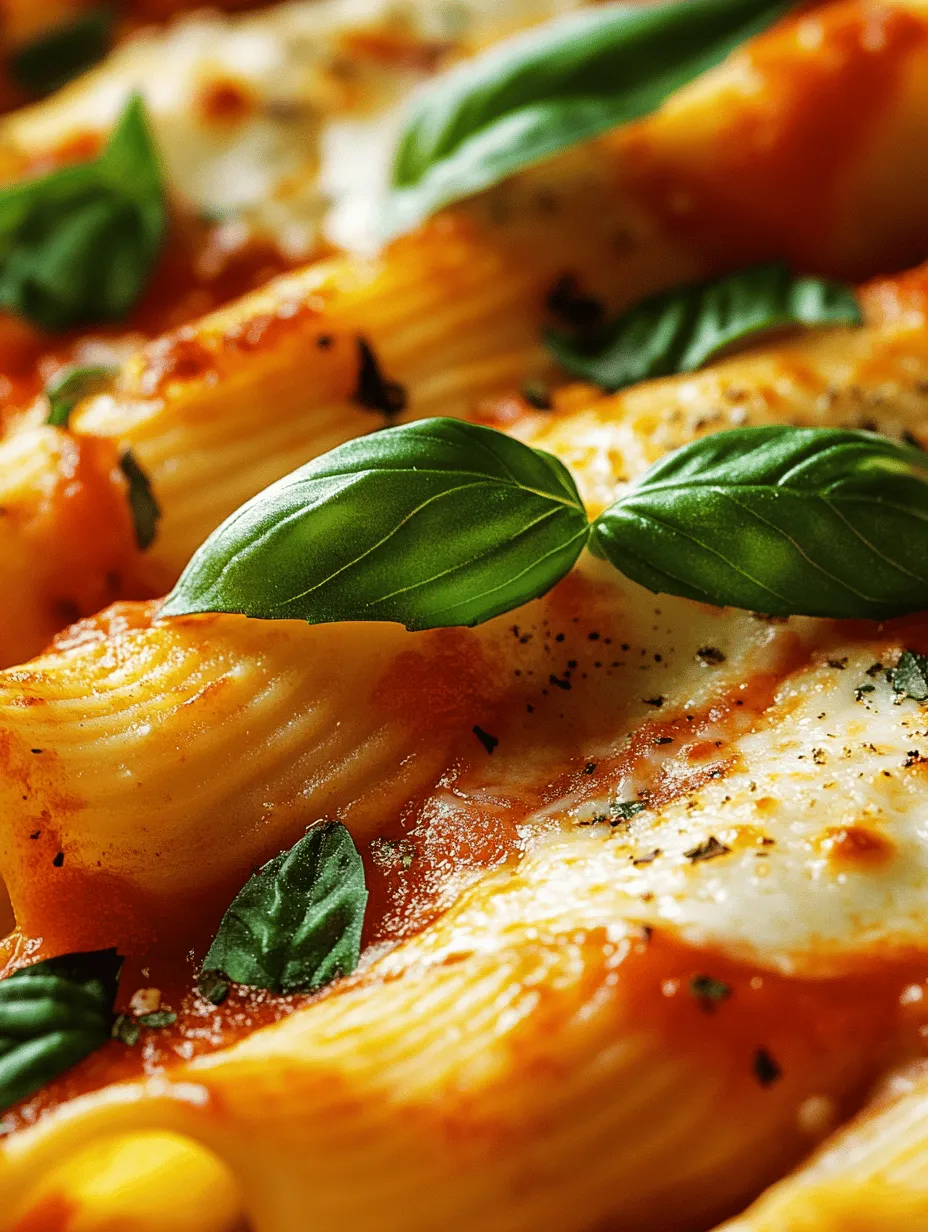In the world of Italian cuisine, few dishes evoke the warmth and comfort of a homemade meal quite like manicotti. With its delightful combination of tender pasta, rich cheeses, and savory marinara sauce, manicotti offers a dining experience that is both satisfying and memorable. It’s a dish that encapsulates the essence of family gatherings, cozy dinners, and the love of home-cooked meals. Our recipe for Magical Manicotti Moments is designed to elevate your culinary skills while bringing joy to your family table. With a creamy ricotta filling, melty mozzarella, and a touch of fresh basil, this dish is sure to become a staple in your kitchen.
Understanding the Ingredients
To truly appreciate the beauty of manicotti, it’s essential to understand the core components that come together to create this magical dish. Each ingredient plays a vital role, contributing to the flavor, texture, and overall experience.
Manicotti Shells: The Perfect Vessel for Fillings
The star of any manicotti dish is undoubtedly the pasta itself. Manicotti shells are large, tubular pasta specifically designed for filling. Their shape allows for generous portions of filling, ensuring that each bite is packed with flavor. When cooked to al dente perfection, these shells provide a satisfying bite and hold up beautifully against the rich sauce and cheese. Look for high-quality manicotti shells in your local grocery store or specialty Italian market for the best results.
Ricotta Cheese: Creamy Texture and Rich Flavor
Ricotta cheese is a key ingredient in the filling of manicotti. Its creamy texture and mild flavor serve as the perfect base for enhancing the dish. Ricotta’s ability to absorb flavors makes it an ideal canvas for adding herbs, spices, and other cheeses. Many people also appreciate the nutritional benefits of ricotta, as it is lower in fat compared to other cheeses and provides a good source of protein.
Mozzarella Cheese: Melting Properties and Taste
No manicotti would be complete without the inclusion of mozzarella cheese. Known for its excellent melting properties, mozzarella adds a gooey, stretchy texture to the filling that is simply irresistible. Whether you choose fresh mozzarella or the shredded variety, this cheese brings a mild flavor that complements the other ingredients. For that classic Italian touch, consider using a blend of both types for added flavor complexity.
Parmesan Cheese: Adding Depth and Umami
Parmesan cheese is the secret ingredient that elevates the flavor profile of your manicotti. Its sharp, nutty taste adds depth and umami, enhancing the overall experience of the dish. Grated or shredded Parmesan can be mixed into the filling or sprinkled on top before baking for a deliciously crispy finish. Quality matters here, so opt for freshly grated Parmesan whenever possible to unlock its full flavor potential.
Marinara Sauce: The Heart of the Dish
A well-made marinara sauce is the heart of any manicotti recipe. This classic tomato-based sauce, bursting with flavor from garlic, onions, and herbs, serves as the perfect companion to the cheesy filling. You can opt for a store-bought sauce for convenience, but nothing compares to a homemade marinara that simmers on the stove, filling your kitchen with its aromatic fragrance. Using fresh tomatoes or quality canned tomatoes will make all the difference in achieving that rich, robust flavor.
Fresh Herbs and Spices: Elevating Flavors
To finish off your Magical Manicotti Moments, don’t forget the importance of fresh herbs and spices. Fresh basil, parsley, and oregano can brighten the dish and offer a burst of flavor that complements the richness of the cheese and sauce. A pinch of black pepper and a dash of red pepper flakes can also add a subtle kick. Fresh herbs not only enhance the taste but also add a pop of color, making your dish visually appealing.
Preparation Techniques
Now that we’ve explored the ingredients that make up this delightful dish, let’s dive into the preparation techniques that will guide you through crafting your Magical Manicotti Moments.
Prepping the Manicotti Shells
The first step in preparing your manicotti is cooking the shells to al dente perfection. This is crucial as overcooked shells can become too soft and difficult to handle, making the filling and baking process a challenge.
1. Cooking the Shells: Fill a large pot with water, add a generous pinch of salt, and bring it to a rolling boil. Carefully add the manicotti shells and cook according to the package instructions, usually around 7-9 minutes. Stir gently to prevent sticking. Aim for al dente; the shells will continue to cook in the oven.
2. Cooling and Handling the Shells Safely: Once the shells are cooked, drain them in a colander and run cold water over them to stop the cooking process. This also helps to cool them down, making them easier to handle. Lay the shells on a clean kitchen towel or parchment paper to dry before filling.
Creating the Cheese Filling
While the shells are cooling, it’s time to prepare the cheese filling that will bring your manicotti to life. This is where you can get creative with flavors and textures.
1. Mixing the Ricotta, Mozzarella, and Parmesan: In a large mixing bowl, combine the ricotta cheese, shredded mozzarella, and grated Parmesan. Use a spatula or fork to mix until well integrated. The combination of these cheeses will create a creamy, flavorful filling that’s sure to impress.
2. The Role of Egg in Binding the Filling: To help bind the filling together, crack an egg into the mixture. The egg acts as a stabilizer, ensuring that the filling holds its shape when baked. Mix thoroughly until the egg is fully incorporated.
3. Incorporating Herbs and Spices for Flavor Enhancement: Now it’s time to add your fresh herbs and spices. Chop a handful of fresh basil and parsley, and fold them into the cheese mixture. Add a pinch of salt and pepper to taste, and if you like a little heat, consider adding some red pepper flakes. This step allows the filling to be as flavorful as possible, ensuring every bite is packed with deliciousness.
Assembling the Dish
Now that you have your manicotti shells cooked and your cheese filling prepared, it’s time to assemble your dish. This step is simple but requires a bit of patience and care to ensure that each shell is filled properly.
1. Techniques for Filling Manicotti Shells: Using a piping bag or a sturdy plastic bag with the corner snipped off, carefully fill each manicotti shell with the cheese mixture. If you don’t have a piping bag, you can also use a spoon to fill each shell, but be gentle to avoid tearing the pasta. Aim for each shell to be generously filled, but avoid overstuffing.
2. Layering Marinara Sauce and Cheese: In a baking dish, spread a thin layer of marinara sauce on the bottom to prevent sticking. Place the filled manicotti shells side by side in the dish, then cover them with more marinara sauce. Sprinkle additional mozzarella and Parmesan cheese on top for a golden, bubbly finish.
3. Tips for Even Baking and Presentation: To ensure even baking, cover the dish with aluminum foil for the first half of the cooking time. This helps to retain moisture and prevent the cheese from browning too quickly. Once the manicotti is cooked through, remove the foil for the last few minutes of baking to achieve that perfect golden crust. When serving, let the dish rest for a few minutes before plating to allow the filling to set.
As you embark on creating these Magical Manicotti Moments, remember that the joy of this dish lies not only in the flavors but also in the process of bringing family and friends together around the table. The combination of creamy cheeses, flavorful marinara, and perfectly cooked pasta will create a meal that is sure to be cherished. Stay tuned for the next part of this article, where we will explore some expert tips for achieving the best results and answer common questions about this beloved Italian dish.

Baking Your Manicotti
The Art of Baking for Optimal Flavor
The baking process is a crucial step in transforming your manicotti from a simple pasta dish into a flavorful and hearty meal. Achieving the perfect texture and taste requires attention to detail, beginning with the oven’s temperature.
Preheating the Oven: Why Temperature Matters
Before you even think about sliding your manicotti into the oven, preheating is essential. Set your oven to 375°F (190°C) and allow it to reach the desired temperature before placing your dish inside. This ensures that your manicotti cooks evenly, preventing any sogginess and allowing the cheese on top to melt and bubble beautifully.
Timing the Bake: Ensuring Cheesy Goodness
Once your oven is preheated, cover the manicotti dish with aluminum foil and bake for 25 minutes. This initial covered phase allows the pasta to steam, softening it and ensuring that the filling warms through. After 25 minutes, carefully remove the foil. This is where the magic happens—return the manicotti to the oven for an additional 15 to 20 minutes. This uncovered baking allows the top layer of cheese to develop a golden brown crust, adding both flavor and texture. Keep an eye on the cheese; you want it bubbly and lightly browned, but not burnt.
Finishing Touches: Removing Foil for a Golden Crust
After the final baking time, remove the manicotti from the oven and allow it to cool for about 5 to 10 minutes. This resting time is vital as it helps the filling set a bit, making it easier to serve without falling apart. The final visual appeal is important, as the golden crust and bubbling sauce will entice your guests long before they take a bite.
Serving Suggestions
Elevating Your Presentation
Plating your manicotti in an aesthetically pleasing manner can elevate the dining experience. Start by using a large, shallow dish to serve your manicotti. Place a generous amount of marinara sauce at the bottom and layer your manicotti on top. This not only adds color but prevents the pasta from sticking to the plate.
Garnishing with Fresh Basil: A Final Touch of Flavor
To enhance both the flavor and presentation, sprinkle freshly chopped basil on top of the baked manicotti just before serving. The bright green color contrasts beautifully against the rich red sauce and creamy cheese, while the aromatic basil adds a refreshing note that complements the dish perfectly. For an extra touch, consider grating a bit of fresh Parmesan over the top just before serving.
Complementary Side Dishes
Pairing your manicotti with complementary side dishes can create a well-rounded meal. Consider serving a crisp Caesar salad or a light arugula salad dressed with lemon vinaigrette. The acidity in the dressing will cut through the richness of the cheese, providing a delightful balance.
Wine Pairings that Complement the Flavors of Manicotti
When it comes to wine, a medium-bodied red like Chianti or a Sangiovese will pair beautifully with your manicotti. These wines have enough acidity to complement the tomato sauce while enhancing the flavors of the cheese and filling. If you prefer white wine, a crisp Pinot Grigio will also work well, providing a refreshing contrast to the dish.
Health Benefits of Manicotti
Nutritional Insights
While manicotti is often thought of as an indulgent dish, it can also offer nutritional benefits, especially when made with wholesome ingredients. The main components—pasta, cheese, and tomato sauce—provide a balanced mix of carbohydrates, protein, and vitamins.
Overview of the Nutritional Value of Key Ingredients
– Pasta: A source of carbohydrates, pasta provides energy and can be made from whole grains for added fiber.
– Cheese: Rich in calcium and protein, cheese is also a good source of vitamins A and B12, supporting bone health and overall well-being.
– Tomato Sauce: Packed with vitamins C and K, and antioxidants like lycopene, tomato sauce has health benefits such as supporting heart health and reducing inflammation.
Balancing Indulgence with Healthy Choices
To create a healthier version of manicotti, consider using whole wheat or gluten-free pasta. You can also incorporate more vegetables into the filling, such as spinach, zucchini, or mushrooms, boosting the dish’s nutritional profile while adding flavor and texture. Additionally, using part-skim ricotta or mozzarella can reduce the fat content without sacrificing taste.
Cultural Significance of Manicotti
A Look into Italian Culinary Traditions
Manicotti, which translates to “sleeves” in Italian, is a dish rich in history and cultural significance. Originating from Southern Italy, this dish has become a staple in Italian-American cuisine, often served during special occasions and family gatherings.
The History of Manicotti in Italian Cuisine
Traditionally, manicotti was created as a way to utilize leftover pasta. The large shells were filled with various ingredients, showcasing the resourcefulness of Italian home cooks. Over the years, manicotti has evolved, with many variations emerging, each reflecting local ingredients and traditions.
How This Dish Varies Across Regions in Italy
In Italy, you may find manicotti filled not just with ricotta but also with meat or various vegetables, depending on regional preferences. In some areas, the dish is baked with béchamel sauce instead of tomato sauce, offering a creamy alternative that’s equally delicious. This regional diversity illustrates the adaptability of manicotti to different tastes and cooking styles.
Conclusion: The Joy of Magical Manicotti Moments
Creating and enjoying manicotti is more than just a meal; it is an experience that brings people together. The process of preparing this dish, from making the filling to baking it to perfection, is an opportunity to connect with family and friends, sharing stories and laughter around the dinner table.
As you savor each bite of your homemade manicotti, reflect on the rich culinary traditions that have shaped this beloved dish. Celebrate the flavors, the ingredients, and the memories created during the cooking process. Encourage your loved ones to take part in the cooking, making it a shared experience that fosters connection.
Remember, the joy of cooking extends beyond the kitchen. It lies in the moments shared with those you love, around a table filled with delicious food. So, prepare your magical manicotti, invite your friends and family over, and relish the flavors and traditions that make homemade meals so special. Savor every bite, and don’t forget to share your culinary creations and experiences with others—after all, good food is meant to be enjoyed together.


